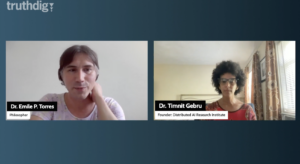The New Optimist Movement Has a Numbers Problem
How Steven Pinker and his merry band of extreme optimists downplay the persistence of widespread human suffering and misery. Graphic by Truthdig
Graphic by Truthdig
It’s no secret that the culture is saturated with doom and gloom, from post-apocalyptic hellscapes in film and literature, to expert warnings about imminent catastrophe brought about by culprits from climate change to artificial intelligence. A quieter presence in the culture exists at the far opposite end of the spectrum. This is the very different narrative of a group of so-called New Optimists, who over the past decade and a half have been promoting the idea that the world is drastically improving by nearly every metric and has been for a long time. Rates of violence and crime are falling, wars and terrorist attacks are becoming less frequent, life expectancy is rising. On and on go the examples of “progress.”
But there’s a problem with how New Optimists support their counterintuitive claims that has not received as much attention as it deserves. This extends to the leaders of the movement, the Harvard psychologist Steven Pinker, author of two New Optimism bestsellers, and Max Roser, who runs the website “Our World in Data,” which provides graphs and charts that ostensibly support Pinker’s claim that we live in the best-ever period of history.
The New Optimists argue that when evaluating the state of our world, one must focus not on the headlines but the trendlines. “If it bleeds, it leads” is the guiding principle of news outlets, and consequently such outlets tend to fixate on the worst things happening around the world. This is why the headlines are full of gloom and doom. However, the New Optimists contend that focusing on the trendlines — changes in the statistical frequency of bad things over time — reveals that the world has never been better, a surprising fact that we should celebrate.
The New Optimists contend that focusing on the trendlines — changes in the statistical frequency of bad things over time — reveals that the world has never been better.
Take violence, for example. In two bestselling books — 2011’s “The Better Angels of Our Nature” and 2018’s “Enlightenment Now” — Pinker argues that violence has significantly declined over the past few decades, centuries, and even millennia, making our present moment the most peaceful ever. Roser compiles data on his website that seems to prove this trend: Homicides, for example, have significantly declined since the early 1500s, according to a chart on the “Homicide data” page. So has the “rate of interstate conflicts,” according to another article on Roser’s website.
The problem is that the New Optimists focus only on relative, or statistical, violence. As Pinker writes, “the only sound way to appraise the state of the world is to count. How many violent acts has the world seen compared with the number of opportunities?” (italics added). This view implies that 10 murders is less bad if the total population is larger, and more bad if the total population is smaller. Why? Because if the population is larger, 10 murders is a smaller percentage of people having died, and what matters to them is this comparative — to borrow Pinker’s word — rate of murder. Hence, if the percentage of people who have been victimized is falling, the New Optimists will conclude that the world is getting better.
Is this the right way to measure violence, though? If one takes seriously the idea that every human life has some inherent, unconditional value, and that the loss of each human life constitutes a profound tragedy independent of any other facts about our world, then the right way to measure violence would be in absolute rather than relative terms. If 10 people are murdered one year and then 20 people are murdered the next, the situation has become worse, in my view. This would be true even if the human population were to have grown such that 20 murders is statistically smaller than 10 murders.
Let me illustrate with another example. Imagine a fictional world extending across three centuries of its existence. In the first century, the total population is one billion people. In the second century, the total population is 10 billion people. In the third century, the total population is 100 billion. The total population is thus growing over time. Now let’s say that during the first century, 30 percent of the population dies in violent conflicts. During the second century, 20 percent die in conflicts. And during the third century, 10 percent die in conflicts. So, while the population is growing, the percentage of deaths is declining.
The New Optimists would declare this a victory, an example of progress. They would say that the trendline is clear: Violence is declining and, consequently, this fictional world is getting better over these three centuries. But what if this particular trendline isn’t what matters, morally speaking? Consider that, as the percentage of deaths relative to the entire human population is falling, the total number of such deaths is simultaneously rising: 30 percent of one billion is 300 million; 20 percent of 10 billion is two billion; and 10 percent of 100 billion is a whopping 10 billion. So, despite the downward statistical trend, the absolute number of deaths has grown from 300 million to 2 billion to 10 billion.
From this perspective — which, again, takes seriously the value of each individual life — the fictional world has actually become worse. This is why the claims of New Optimists are deeply misguided: The percentage of deaths isn’t that important, morally speaking. What should matter is the total number of such deaths. More generally, I would argue that what’s relevant when evaluating the world and determining whether it’s getting better or worse is the amount of human suffering— of any kind — that it contains. Focusing only on the percentage of deaths is a moral insult to the value of each life.
The percentage of deaths isn’t that important, morally speaking. What should matter is the total number of such deaths.
I mention this fictional world because it is a lot like ours. Even if one accepts that violence has declined in a statistical sense, the total amount of violence has risen significantly over time. Why? Partly because the human population has grown enormously over the past several centuries. Consider that just 100 years ago, in 1927, there were only 2 billion people on Earth. Today, there are over 8 billion, and this number is expected to increase to around 10 billion later this century. If what matters, morally, is the amount of suffering, then there’s actually a very strong case for the exact opposite conclusion drawn by New Optimists like Pinker and Roser: That the world has never been worse than it is right now, and for reasons discussed below things will almost certainly worsen even more in the coming decades.
Consider a few dismal facts about our world today. Every year, an average of 580,000 people die violently, while 440,000 people are murdered. In the US alone, roughly 463,000 people are raped or sexually assaulted, about 600,000 children are abused each year, and about 840,000 children are abducted or go missing, resulting in an average of one child disappearing every 40 seconds. Globally, about 1.2 billion human beings live in acute multidimensional poverty, with 712 million suffering from extreme poverty, a number that has risen by 23 million since 2019. About 735 million are malnourished, and 25,000 people die every day from hunger or hunger-related illnesses, including 10,000 children. A staggering 2 billion people don’t have access to clean water, while another 150 million worldwide are homeless. About 1.4 billion children live on $6.85 or less per day, and an estimated 50 million people are trapped in modern-day slavery. Incredibly, about 1.3 million refugees in the United States have survived torture, a form of suffering that, according to some survivors, is so unimaginably horrible that it has no point of reference in our normal lives.
About 800 million children suffer from lead poisoning, which causes permanent brain damage. That’s more than 1/3 of all children around the world and roughly twice the population of the United States. Another 140 million people are affected by arsenic poisoning, while 18.5 million die every year from heart disease and 10 million from cancers, which amounts to roughly 27,600 cancer deaths every day, or three human beings dying per second. An estimated 55 million people around the world have dementia, and about 139 million are projected to have dementia by 2050. Seven million or so die annually from air pollution, while nearly 70 million Americans struggle with chronic sleep disorders, 51 million Americans suffer from chronic pain, and about 40 million people in the United States take antidepressants. An even higher number — 46.8 million — battle drug and alcohol abuse each year, with over 178,000 dying of alcohol-related diseases every 12 months. Over 253 million Americans report that “they have experienced health impacts due to stress in the prior month,” while some 89 million say that they feel so stressed out most days that they are unable to function normally. Globally, 280 million people deal with depression and 301 million suffer from anxiety disorders.
These numbers are mind-boggling. Our brains fail to comprehend big numbers like those above. As a professor of mine used to say, “humans are qualitative geniuses, but quantitative imbeciles.” What he meant is that we are great at qualitative tasks like recognizing faces, but we are utterly incapable of grasping numbers as they become very large.
One way to wrap your head around big numbers is to break them down into smaller sums. For example, nearly 2 million Palestinians have been forced to relocate due to the genocidal war in Gaza. The number 2 million looks big, but it doesn’t hit us in the moral gut the way it really should. Hence, to grasp the sheer enormity of this crime against humanity — forced relocation — it may be useful to write out 2 million as a list of “100,000” 20 times as follows; this will get tedious, but the tedium is part of the point: Two million displaced Palestinians is the same as 100,000 displaced humans, plus 100,000 displaced humans, plus 100,000 displaced humans, plus 100,000 displaced humans, plus 100,000 displaced humans, plus 100,000 displaced humans, plus 100,000 displaced humans, plus 100,000 displaced humans, plus 100,000 displaced humans, plus 100,000 displaced humans, … and so on, 10 more times. Suddenly, the reality of the situation starts to look so much worse.

If what matters morally is the absolute numbers — because each individual life has inherent, unconditional value — this method of breaking down big numbers can help one make sense of just how much catastrophic human suffering there is all around us. It reveals, quite clearly, that our world is something of a horror show, a waking nightmare, and it makes the conclusion that things have never been worse very difficult to resist. I strongly doubt that there has ever been more human misery on Earth than there is right now. And, as noted above, the worst is probably yet to come. Why?
Well, consider that there could be 2 billion people who are forced to migrate this century due to climate change. They will become “climate refugees.” Another 1 billion are projected to die as a direct result of climate change. Try to break these numbers down into units of 100,000 and you will quickly fill up more than 40 pages. Furthermore, studies show that up to about 74 percent humanity will become vulnerable to lethal heat waves by 2100 if carbon emissions continue to grow, with some of these events exceeding the 95-degree wet-bulb threshold of human survivability, meaning that even if one were naked in front of a giant fan while standing in the shade and being completely hydrated, one would still perish. Similarly, about 30 percent of our planet will become arid land if temperatures rise above 2 degrees Celsius, which seems probable given that the last 12 months have been 1.6 degrees Celsius above pre-industrial levels. We have lost half of the world’s topsoil over the past 150 years, and soil productivity is projected to decline by 10 percent by 2050, yet studies indicate that we will need to “produce more food in the next four decades than we have in the last 8,000 years of agriculture combined.”
This is the dismal future that we are racing into; it is the precipice that we, as a species, are accelerating toward. Huge numbers of people are going to suffer terribly. An unfathomable number of human beings will die horrible deaths due to devastating floods, raging wildfires, Category 6 storms, heatwaves and catastrophic famines. The New Optimists don’t take these facts seriously enough, in my opinion. In fact, they tend to have a rather rosy view about how technological innovation will save humanity from disaster, a position called eco-modernism that Pinker has defended.
Yet climate change and environmental degradation aren’t the only phenomena that the New Optimists frequently ignore in claiming that the world has never been better. Consider the case of toxic chemicals. Our world today is awash in toxins that most of our ancestors just 100 years ago would have never come into contact with, or at least not in the doses that we are often exposed to. For example, almost everyone today ingests microplastics, which are found in both bottled water and the public water system, meaning that most of us cannot escape these nasty little particles. Microplastics can infiltrate every organ in the body, including the brain, causing “oxidative stress, DNA damage, organ dysfunction, metabolic disorder, immune response, neurotoxicity, as well as reproductive and developmental toxicity.” These chemicals are so pervasive that scientists have even discovered them accumulating on the bottom of seas and oceans, including in the deepest crevasse on Earth’s wrinkled crust, the Mariana Trench.
It reveals, quite clearly, that our world is something of a horror show, a waking nightmare, and it makes the conclusion that things have never been worse very difficult to resist.
Other studies report that 97 percent of Americans have detectable quantities of PFAS in their bodies. PFAS have been dubbed “forever chemicals” because they will linger in the environment for literally thousands of years, and even small doses are linked to “a wide variety of health problems, including kidney and testicular cancer, liver problems, high cholesterol, and immunosuppression.”
The startling fact is that there is mercury in fish, cadmium in chocolate bars, lead in wine and alcohol, organophosphates on fruits and vegetables, phthalates in our food, volatile organic compounds (VOCs) in household products, and neurotoxic BPS in store receipts. Endocrine-disrupting chemicals are in everything from “canned baby food to scented shampoos,” and a recent study found that 25 percent of children’s toys contain dangerous chemicals. Perhaps the ubiquity of such chemicals and neurotoxins is why early-onset dementia is becoming more common (a 131 percent increase in Alzheimer’s diagnoses among under-65s between 2013 and 2017), and why the rates of over 12 types of cancers are also rising among young people.
There are other trendlines that the New Optimists conveniently ignore, as well. Take the prevalence of loneliness. Since the 1980s, rates of loneliness have doubled in the United States, and a 2018 survey found that 54 percent of Americans sometimes or always “feel as though no one knows them well,” with 46 percent saying that they are “sometimes or always feeling alone” in the world. This is a new phenomenon, as some historians have argued that people in the past probably didn’t experience, the way we do, the feeling of loneliness, a word that doesn’t really appear in Western literature prior to 1800. They may have been alone, but they were not lonely. Loneliness is linked to heart disease and stroke, addiction, depression and anxiety, suicide and self-harm, dementia and premature death.
Or consider the growing chasm between the rich and the poor. Globally, the top 10 percent of wealthiest people own nearly 75 percent of the world’s wealth, and in the United States the three wealthiest people have a higher net worth than the bottom half of society combined. This has become significantly worse since the Covid-19 pandemic. New Optimists such as Pinker argue that such disparities don’t really matter, so long as everyone is becoming a little wealthier. But is that correct? A comprehensive study from 2014 said that the United States is no longer a democracy, but has become an oligarchy, ruled by a small group of super-wealthy, powerful individuals. Meanwhile, fascism and the far-right are on the rise, including within countries such as the United States (Donald Trump), France (Marine Le Pen), Brazil (Jair Bolsonaro), Argentina (Javier Milei), and Hungary (Viktor Orbán), while democracies are in decline, a phenomenon that some call the “democratic recession.”

All of this bodes poorly for the future. From catastrophic climate change to environmental toxins to widening disparities between the rich and poor, such phenomena suggest that a more pessimistic view of what lies ahead is better supported by the relevant trendlines. Similarly, if one takes the value of each human life seriously, then a more pessimistic view of the present also seems warranted, as there has probably never been so much human misery in the world than there is right now.
The obvious next question is: If things have actually gotten worse over time, and if our future on this planet looks very bleak, what should we do? How should we respond to the enormous, complicated mess that we’ve created? The good news is that the world doesn’t have to be like this. We created the mess, so perhaps it’s also within our power to clean it up. For me, at least, recognizing just how relentlessly awful the world is can be a great motivator. The worse things are, the more we should try to make them better through charity, acts of kindness, political activism and the power of the ballot.
This is the upshot of what I would call a more ethical, and thus more pessimistic, view of our situation. When the house is on fire, one runs rather than walks. Given how bad things will become in the future, we should run, rather than walk, to do everything we can to make the world more livable.
Your support is crucial...As we navigate an uncertain 2025, with a new administration questioning press freedoms, the risks are clear: our ability to report freely is under threat.
Your tax-deductible donation enables us to dig deeper, delivering fearless investigative reporting and analysis that exposes the reality beneath the headlines — without compromise.
Now is the time to take action. Stand with our courageous journalists. Donate today to protect a free press, uphold democracy and uncover the stories that need to be told.






You need to be a supporter to comment.
There are currently no responses to this article.
Be the first to respond.